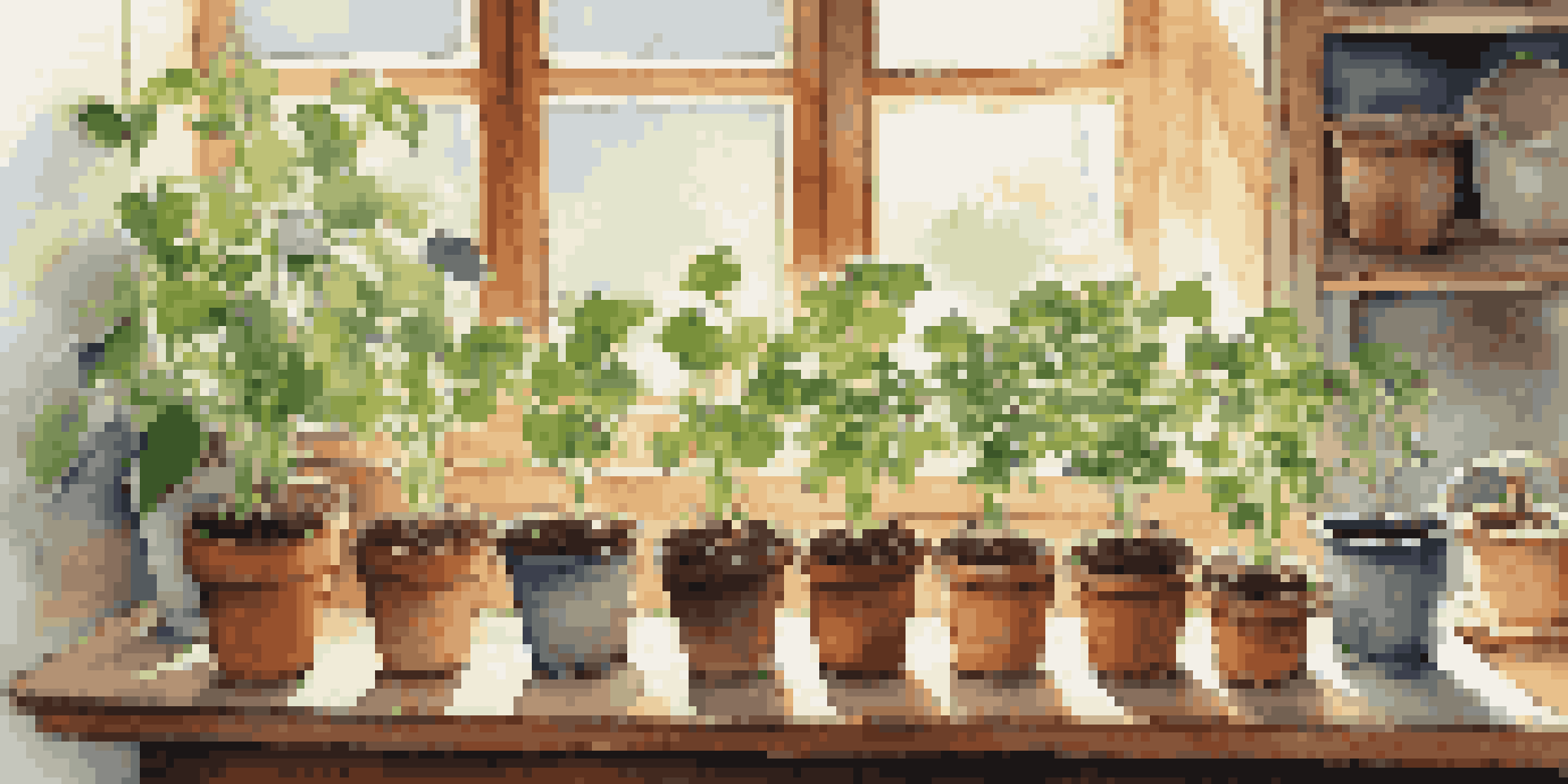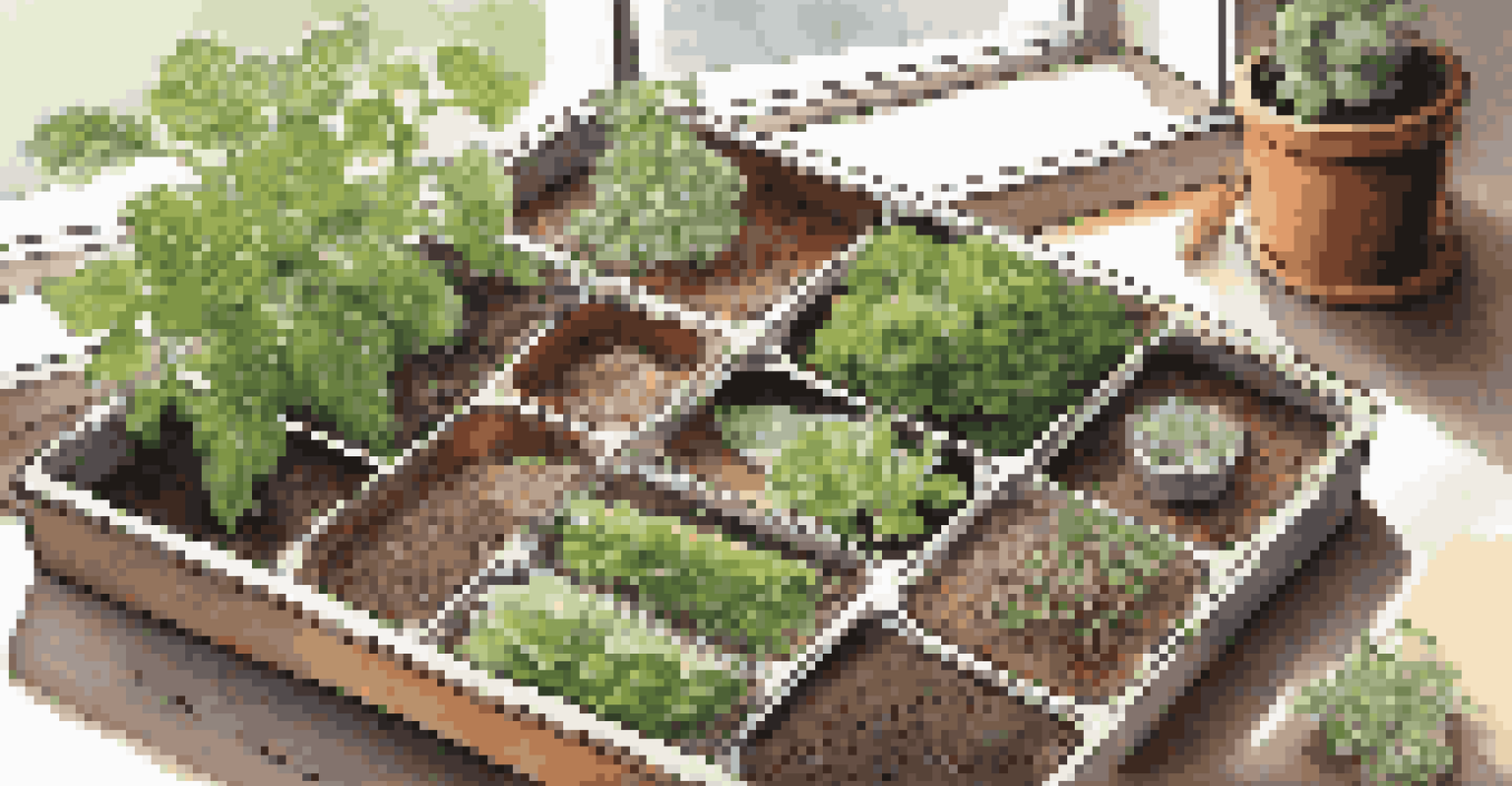How to Grow Indoor Plants from Seeds: A Beginner's Guide

Understanding the Basics of Indoor Seed Growing
Growing indoor plants from seeds can be a rewarding experience, but it starts with understanding the fundamentals. Seeds are the beginning of plant life, and they need specific conditions to thrive. By providing the right environment—light, warmth, and moisture—you can nurture these tiny seeds into beautiful plants. It's like giving a new life a cozy home to grow in.
To plant a garden is to believe in tomorrow.
When you're starting out, it's crucial to choose the right seeds. Some plants are easier to grow indoors than others; herbs like basil and mint are great for beginners. They not only sprout quickly but also add freshness to your home. Think of it as picking the right ingredients for a delicious recipe—you want something that will yield great results without too much fuss.
Finally, remember that patience is key. Plants take time to grow, and every seed is on its own timeline. Just like watching a child grow, you'll need to nurture them and give them space to flourish. With time and care, you'll be rewarded with lush greenery that brightens your indoor space.
Choosing the Right Seeds for Indoor Growth
Selecting the right seeds is essential for a successful indoor garden. Some plants are specifically suited for indoor growth, while others may struggle. Look for seeds labeled as 'indoor' or 'container-friendly,' as these are designed to thrive in limited space. Imagine trying to squeeze a tall tree into a small room—it just won’t work!

Herbs, leafy greens, and small flowering plants are excellent choices for indoor gardening. They tend to grow well in pots and often have shorter growth cycles. Plus, many of them provide the added bonus of being edible or fragrant, enhancing your space with both beauty and utility. It’s like having a mini indoor farm that keeps giving back.
Start with the Right Seeds
Choosing seeds that are suitable for indoor growth, like herbs and small plants, sets the foundation for a successful indoor garden.
Before making your selection, consider your environment. Think about the amount of sunlight your space receives and choose seeds that match those conditions. By aligning your choices with your indoor climate, you're setting yourself up for success. It’s all about finding the perfect match for your growing conditions.
Gathering Essential Supplies for Seed Planting
Before you dive into planting, it's important to gather the right supplies. You'll need seed trays or pots, potting soil, and a watering can, among other essentials. Selecting good quality potting soil is vital, as it provides the necessary nutrients for your seeds to germinate. Think of it as choosing the right foundation for a house—everything else builds upon it.
The love of gardening is a seed once sown that never dies.
Additionally, consider getting a light source if your home lacks natural sunlight. Grow lights can provide the necessary brightness that seeds need to sprout. This is particularly helpful during the darker months when natural light is limited. It’s like having a little sunbeam indoors, encouraging your seeds to wake up and grow.
Lastly, don’t forget about labels! Keeping track of what you’ve planted and when can save you a lot of confusion down the line. By marking your containers, you can monitor growth and plan your care routine accordingly. It's like having a roadmap for your indoor garden adventure.
Preparing Seeds and Soil for Planting
Now that you have your supplies, it’s time to prepare your seeds and soil. Start by filling your pots or seed trays with potting soil, leaving a little space at the top. Lightly pat the soil down, ensuring it’s not too compacted, which can hinder root growth. Picture this step as creating a comfy bed for your seeds; they need a cozy spot to settle into.
Next, check the seed packets for specific planting instructions. Some seeds require soaking or stratifying before planting, which can enhance germination. This process is akin to giving your seeds a little wake-up call, helping them realize it’s time to grow. Following these instructions closely will lead to better results.
Maintain Ideal Growing Conditions
Keeping the right moisture levels and temperatures is crucial for seed germination, ensuring your plants have the best chance to thrive.
Finally, plant the seeds at the recommended depth, usually a couple of times their size. Gently cover them with soil and water them lightly to settle them in. This nurturing touch is essential, as it helps your seeds make contact with the soil, which they need to sprout. Remember, a little care goes a long way in the plant world!
Watering and Maintaining Ideal Growing Conditions
After planting, maintaining the right moisture level is crucial for seed germination. Too much water can drown the seeds, while too little can cause them to dry out. It's a delicate balance, much like watering a delicate flower. Aim to keep the soil consistently moist but not soggy—think of it as keeping a sponge damp but not dripping wet.
Additionally, temperature plays a significant role in seed growth. Most seeds germinate best at temperatures between 65°F and 75°F. Placing your pots in a warm spot, like near a radiator or on a sunny windowsill, can make all the difference. It’s similar to how we feel more energized on a warm, sunny day; your seeds will feel the same way.
Finally, keep an eye on your seedlings as they grow. They may need to be thinned out if they’re overcrowded, allowing the strongest plants to thrive. This is comparable to a crowded party where guests might need a bit more space to enjoy themselves. Giving your plants room to grow will lead to healthier, more robust greenery.
Providing Light: Natural vs. Artificial Options
Light is one of the most critical factors in indoor gardening, especially for seedlings. If your home receives plenty of natural sunlight, placing your pots near a window is ideal. South-facing windows often provide the best light, giving your plants the sunshine they crave. It’s like having a front-row seat to a concert—everyone wants the best view!
However, if sunlight is scarce, consider investing in grow lights. These lights mimic natural sunlight and can be adjusted to provide the right spectrum for plant growth. Position them about 2-4 inches above the seedlings to prevent them from stretching too much toward the light. Think of grow lights as your plants' personal sun, ensuring they get their fill of energy.
Transplant for Healthy Growth
Transplanting seedlings into larger pots allows for continued growth and prevents root binding, promoting a flourishing indoor garden.
Regardless of the light source, be mindful of the duration your plants are exposed to light. Most seedlings thrive with 12-16 hours of light daily. You can use a timer to automate this process, making it easier to maintain a consistent schedule. It’s like setting an alarm for your plants—they need their daily dose of sunshine to stay happy and healthy.
Transplanting Seedlings for Continued Growth
Once your seedlings have established a few sets of true leaves, it’s time to consider transplanting them. This process involves moving them to larger pots or directly into your indoor garden. Think of it as sending your kids off to college; they need more space to grow and flourish. Transplanting helps prevent root binding and allows for healthier development.
Before transplanting, ensure the new pots have drainage holes to prevent water accumulation. Gently loosen the soil around the seedlings and lift them by their leaves, avoiding any damage to the delicate roots. It’s important to handle them with care, much like cradling a fragile egg—it takes just the right touch to keep them safe.

After transplanting, give your seedlings a good drink of water and place them in a spot where they can acclimate to their new surroundings. Monitor their growth closely and adjust your care routine as needed. This transitional phase is crucial, as it sets the stage for a thriving indoor garden that can continue to grow and inspire.